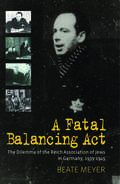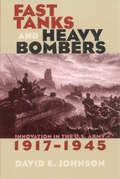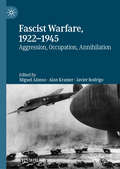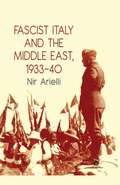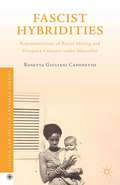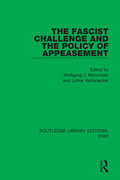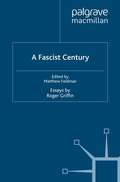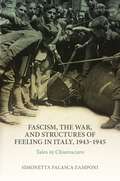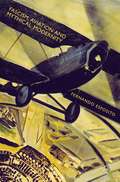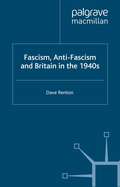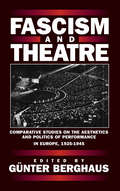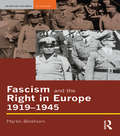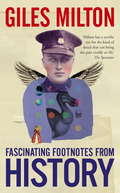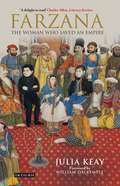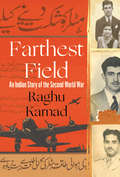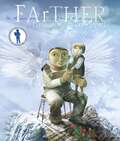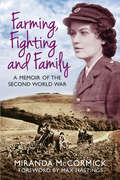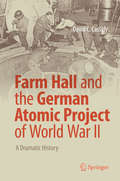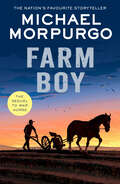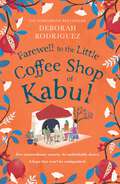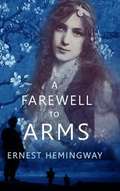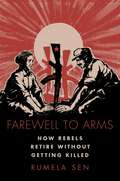- Table View
- List View
A Fatal Balancing Act: The Dilemma of the Reich Association of Jews in Germany, 1939-1945
by Beate MeyerIn 1939 all German Jews had to become members of a newly founded Reich Association. The Jewish functionaries of this organization were faced with circumstances and events that forced them to walk a fine line between responsible action and collaboration. They had hoped to support mass emigration, mitigate the consequences of the anti-Jewish measures, and take care of the remaining community. When the Nazis forbade emigration and started mass deportations in 1941, the functionaries decided to cooperate to prevent the “worst.” In choosing to cooperate, they came into direct opposition with the interests of their members, who were then deported. In June 1943 all unprotected Jews were deported along with their representatives, and the so-called intermediaries supplied the rest of the community, which consisted of Jews living in mixed marriages. The study deals with the tasks of these men, the fate of the Jews in mixed marriages, and what happened to the survivors after the war.
Fast Tanks and Heavy Bombers: Innovation in the U.S. Army, 1917–1945 (Cornell Studies in Security Affairs)
by David E. JohnsonThe U.S. Army entered World War II unprepared. In addition, lacking Germany's blitzkrieg approach of coordinated armor and air power, the army was organized to fight two wars: one on the ground and one in the air. Previous commentators have blamed Congressional funding and public apathy for the army's unprepared state. David E. Johnson believes instead that the principal causes were internal: army culture and bureaucracy, and their combined impact on the development of weapons and doctrine. Johnson examines the U.S. Army's innovations for both armor and aviation between the world wars, arguing that the tank became a captive of the conservative infantry and cavalry branches, while the airplane's development was channeled by air power insurgents bent on creating an independent air force. He maintains that as a consequence, the tank's potential was hindered by the traditional arms, while air power advocates focused mainly on proving the decisiveness of strategic bombing, neglecting the mission of tactical support for ground troops. Minimal interaction between ground and air officers resulted in insufficient cooperation between armored forces and air forces. Fast Tanks and Heavy Bombers makes a major contribution to a new understanding of both the creation of the modern U.S. Army and the Army's performance in World War II. The book also provides important insights for future military innovation.
Fascist Warfare, 1922–1945: Aggression, Occupation, Annihilation
by Miguel Alonso Alan Kramer Javier RodrigoThis groundbreaking book explores the interpretative potential and analytical capacity of the concept ‘fascist warfare’. Was there a specific type of war waged by fascist states? The concept encompasses not only the practice of violence at the front, but also war culture, the relationship between war and the fascist project, and the construction of the national community. Starting with the legacy of the First World War and using a transnational approach, this collection presents case studies of fascist regimes at war, spanning Nazi Germany, Fascist Italy, Francoist Spain, Croatia, and Imperial Japan. Themes include the idea of rapid warfare as a symbol of fascism, total war, the role of modern technology, the transfer of war cultures between regimes, anti-partisan warfare as a key feature, and the contingent nature and limits of fascist warfare.
Fascist Italy and the Middle East, 1933–40
by N. ArielliAn examination of why and how Fascist Italy sought to increase its influence in the Middle East, and why Italian efforts ultimately failed. Offering fresh insights into Fascist Italy's foreign and colonial policies, this book makes an important contribution to the complex history of relations between Europe and the Arab world.
Fascist Hybridities: Representations of Racial Mixing and Diaspora Cultures under Mussolini (Italian and Italian American Studies)
by Rosetta Giuliani CaponettoUnder Italian Fascism, African-Italian mulattoes and white Italians living in Egypt posed a particular threat to the pursuit of a homogenous national identity. This book examines novels and films of the period, showing that their attempts at stigmatization were self-undermining, forcing audiences to reassess their collective identity.
The Fascist Challenge and the Policy of Appeasement (Routledge Library Editions: WW2 #8)
by Lothar Kettenacker Wolfgang J. MommsenThis book, first published in 1983, illustrates the domestic and internal dimension of appeasement and explores the political options open to the western powers in the run up to the Second World War. It looks at the factors pointing in the direction of a general settlement with the dictators: limitation of resources and strategic over-commitment by Britain; economic decline and financial exhaustion of France; lack of support from the United States and the Soviet Union.
The Fascist Challenge and the Policy of Appeasement (Routledge Library Editions: WW2 #8)
by Wolfgang J. Mommsen and Lothar KettenackerThis book, first published in 1983, illustrates the domestic and internal dimension of appeasement and explores the political options open to the western powers in the run up to the Second World War. It looks at the factors pointing in the direction of a general settlement with the dictators: limitation of resources and strategic over-commitment by Britain; economic decline and financial exhaustion of France; lack of support from the United States and the Soviet Union.
A Fascist Century: Essays by Roger Griffin
by R. GriffinTen essays on the nature of fascism by a leading scholar in the field, focusing on how to understand and apply fascist ideology to various movements since the twentieth century, Mussolini's prophesied 'fascist century'. Includes studies of fascism's attempted temporal revolution; Nazism as extended case-study; and fascism's postwar evolution.
Fascism, the War, and Structures of Feeling in Italy, 1943-1945: Tales in Chiaroscuro
by Prof Simonetta Falasca-ZamponiOn July 25, 1943, news of Mussolini's resignation and subsequent arrest stunned Italians leaving them dumbfounded. After two decades, fascism had fallen without any advance warning. As festive events marked the incredible outcome and reminders of the past were destroyed, an uncontainable joy seemed to pervade Italians. But what did people actually celebrate? How did they understand the bygone dictatorship, which was soon to be reincarnated in the Italian Social Republic (RSI)? Drawing on more than one hundred diaries written by ordinary citizens (and some prominent figures as well) and inspired by Raymond Williams's concept of structures of feeling, the book examines Italians' perspectives on fascism at a very critical moment in their history. With the country mired in a devastating war further complicated by the September 8, 1943 armistice with the Allies and subsequent German occupation—followed by the eruption of an Italian-against-Italian conflict, the switching of alliances, and the declaration of war against Germany on October 13, 1943—the fast pace of history seemed to deflect Italians' attention from their immediate past. Amidst the daily experience of bombings, hunger, displacement, and death, coming to terms with twenty years of dictatorship turned out to be an arduous enterprise. Whether those who had lived under the fascist regime wished 'not to think of it and not to speak any more about it' as philosopher Benedetto Croce maintained, it is hard to ascertain. In truth, little is known of what Italians felt and thought about fascism after its precipitous demise. This book remedies the gap in historical scholarship by assessing how Italians confronted their present and negotiated their past during the two years from the fall of the regime to the definitive defeat of the RSI and the end of the world war in May 1945. By bringing to life the cultural imaginaries and practices of the past, the book raises ostensibly intractable questions on the epochal impact of what often appears as inconsequential: the typically unseen and seemingly banal power of everyday experiences.
Fascism, the War, and Structures of Feeling in Italy, 1943-1945: Tales in Chiaroscuro
by Prof Simonetta Falasca-ZamponiOn July 25, 1943, news of Mussolini's resignation and subsequent arrest stunned Italians leaving them dumbfounded. After two decades, fascism had fallen without any advance warning. As festive events marked the incredible outcome and reminders of the past were destroyed, an uncontainable joy seemed to pervade Italians. But what did people actually celebrate? How did they understand the bygone dictatorship, which was soon to be reincarnated in the Italian Social Republic (RSI)? Drawing on more than one hundred diaries written by ordinary citizens (and some prominent figures as well) and inspired by Raymond Williams's concept of structures of feeling, the book examines Italians' perspectives on fascism at a very critical moment in their history. With the country mired in a devastating war further complicated by the September 8, 1943 armistice with the Allies and subsequent German occupation—followed by the eruption of an Italian-against-Italian conflict, the switching of alliances, and the declaration of war against Germany on October 13, 1943—the fast pace of history seemed to deflect Italians' attention from their immediate past. Amidst the daily experience of bombings, hunger, displacement, and death, coming to terms with twenty years of dictatorship turned out to be an arduous enterprise. Whether those who had lived under the fascist regime wished 'not to think of it and not to speak any more about it' as philosopher Benedetto Croce maintained, it is hard to ascertain. In truth, little is known of what Italians felt and thought about fascism after its precipitous demise. This book remedies the gap in historical scholarship by assessing how Italians confronted their present and negotiated their past during the two years from the fall of the regime to the definitive defeat of the RSI and the end of the world war in May 1945. By bringing to life the cultural imaginaries and practices of the past, the book raises ostensibly intractable questions on the epochal impact of what often appears as inconsequential: the typically unseen and seemingly banal power of everyday experiences.
Fascism, Aviation and Mythical Modernity
by Fernando EspositoFlying and the pilot were significant metaphors of fascism's mythical modernity. Fernando Esposito traces the changing meanings of these highly charged symbols from the air show in Brescia, to the sky above the trenches of the First World War to the violent ideological clashes of the interwar period.
Fascism, Anti-Fascism and Britain in the 1940s
by D. RentonDespite the Second World War and the Holocaust, postwar Britain was not immune to fascism. By 1948, a large and confident fascist movement had been established, with a strong network of local organisers and public speakers, and an audience of thousands. However, within two years the fascists had collapsed under the pressure of a successful anti-fascist campaign. This book explains how it was that fascism could grow so fast, and how it then went into decline.
Fascism and Theatre: Comparative Studies on the Aesthetics and Politics of Performance in Europe, 1925-1945
by Günter BerghausSince the 1920s, an endless flow of studies has analyzed the political systems of fascism, theseizure of power, the nature of the regimes, the atrocities committed, and, finally, the wars waged against other countries. However, much less attention has been paid to the strategies of persuasion employed by the regimes to win over the masses for their cause. Among these, fascist propaganda has traditionally been seen as the key means of influencing public opinion. Only recently has the "fascination with Fascism" become a topic of enquiry that has also formed the guiding interest of this volume: it offers, for the first time, a comparative analysis of the forms and functions of theater in countries governed by fascist or para-fascist regimes. By examining a wide spectrum of theatrical manifestations in a number of States with a varying degree of fascistization, these studies establish some of the similarities and differences between the theatrical cultures of several cultures in the interwar period.
Fascism and the Right in Europe 1919-1945
by Martin BlinkhornThis new text places interwar European fascism squarely in its historical context and analyses its relationship with other right wing, authoritarian movements and regimes. Beginning with the ideological roots of fascism in pre-1914 Europe, Martin Blinkhorn turns to the problem-torn Europe of 1919 to 1939 in order to explain why fascism emerged and why, in some settings, it flourished while in others it did not. In doing so he considers not just the 'major' fascist movements and regimes of Italy and Germany but the entire range of fascist and authoritarian ideas, movements and regimes present in the Europe of 1919-1945.
Fascism and the Right in Europe 1919-1945
by Martin BlinkhornThis new text places interwar European fascism squarely in its historical context and analyses its relationship with other right wing, authoritarian movements and regimes. Beginning with the ideological roots of fascism in pre-1914 Europe, Martin Blinkhorn turns to the problem-torn Europe of 1919 to 1939 in order to explain why fascism emerged and why, in some settings, it flourished while in others it did not. In doing so he considers not just the 'major' fascist movements and regimes of Italy and Germany but the entire range of fascist and authoritarian ideas, movements and regimes present in the Europe of 1919-1945.
Fascinating Footnotes From History: Fascinating Footnotes from History
by Giles Milton'Giles Milton is a man who can take an event from history and make it come alive . . . an inspiration for those of us who believe that history can be exciting and entertaining' Matthew Redhead, The TimesDid you know that Hitler took cocaine? That Stalin robbed a bank? That Charlie Chaplin's corpse was filched and held to ransom? Giles Milton is a master of historical narrative: in his characteristically engaging prose, Fascinating Footnotes From History details one hundred of the quirkiest historical nuggets; eye-stretching stories that read like fiction but are one hundred per cent fact.There is Hiroo Onoda, the lone Japanese soldier still fighting the Second World War in 1974; Agatha Christie, who mysteriously disappeared for eleven days in 1926; and Werner Franz, a cabin boy on the Hindenburg who lived to tell the tale when it was engulfed in flames in 1937. Fascinating Footnotes From History also answers who ate the last dodo, who really killed Rasputin and why Sergeant Stubby had four legs. Peopled with a gallery of spies, rogues, cannibals, adventurers and slaves, and spanning twenty centuries and six continents, Giles Milton's impeccably researched footnotes shed light on some of the most infamous stories and most flamboyant and colourful characters (and animals) from history.(Previoulsy published in four individual epub volumes: When Hitler Took Cocaine, When Stalin Robbed a Bank, When Lenin Lost His Brain and When Churchill Slaughtered Sheep.)
Farzana: The Woman Who Saved an Empire
by Julia KeayAmongst the riches of 19th century India, as the British fought their way across Mughal territory, an orphaned street-girl is brought to court to perform for the Emperor. That girl was Farzana, and she would become a courtesan, a leader of armies, a treasured defender of the last Mughal emperor and the head of one of the most legendary courts in history. In this beautifully written book, the author's last, Julia Keay weaves a story which spans the Indian continent and the end of a golden era in Indian history, the story of a nobody who became a teenage seductress and died one of the richest and most prominent woman of her age. Farzana rode into battle atop a stallion, though only 4 ½ feet tall, and led an army which defended a sickly Mughal empire. She dabbled in witchcraft while gaining favour with the Pope, and died a favourite of the British Raj. Farzana is an evocative and moving depiction of one of the most remarkable, and least-known, historical lives of the 19th century.
Farthest Field: A Story Of India's Second World War
by Raghu KarnadDescribed as ‘a masterpiece’ by critics, this remarkable book tells the story of war through the lives and deaths of a single family. Absolutely unforgettable new writing. If you loved The English Patient or Rohinton Mistry’s Fine Balance or Katherine Boo’s Behind the Beautiful Forevers, you will love this book.
FArTHER
by Grahame Baker-SmithA young boy, bewitched by his father's passion to fly; a desperate craving that absorbs his every waking minute, finds himself entranced by the dream. When his father goes to war and does not return it seems the spell is broken. Much later, the boy, now a young man, finds himself drawn once more to his father's drawings and failed experiments. Finally able to make his father's dream a reality, he flies.
Farming, Fighting and Family: A Memoir of the Second World War
by Miranda McCormickThe Wiltshire farmer/author/broadcaster Arthur (A.G.) Street was one of the leading voices of British agriculture during WW2. His daughter Pamela – herself an aspiring writer - was eighteen when war broke out. Her contributions to the war effort included working on her father’s farm, nursing in the local military hospital, and serving in the ATS. Her future husband, David McCormick, served with the 4th RHA in North Africa. Captured in December 1941, he endured the remainder of the war in prison camps in Italy and Germany. Miranda McCormick has skilfully woven together her forebears’ very differing wartime experiences. Of specific interest to social, military and agricultural historians, for the general reader this is also an intensely human – at times heart-rending – story of love, duty, separation, temptation, guilt and eventual reunion. Pamela fell in love with an American pilot – but she remained true to David. The strain was so much that she was invalided out of the ATS.
Farm Hall and the German Atomic Project of World War II: A Dramatic History
by David C. CassidyThis gripping book brings back to life the events surrounding the internment of ten German Nuclear Scientists immediately after World War II. It is also an "eye-witness" account of the dawning of the nuclear age, with the dialogue and narrative spanning the period before, during and after atomic bombs were dropped on Japan at the end of the war. This pivotal historical episode is conveyed, along with the emotions as well as the facts, through drama, historical narrative, and photographs of the captive German nuclear scientists - who included Werner Heisenberg, Otto Hahn, and Max von Laue. The unique story that unfolds in the play is based on secretly recorded transcripts of the scientists’ actual conversations at Farm Hall, together with related documents and photographs.
Farm Boy: The Sequel To War Horse
by Michael MorpurgoThe magical sequel to ‘War Horse’, now a major motion picture. Discover the beautiful stories of Michael Morpurgo, author of War Horse and the nation’s favourite storyteller
Farewell to The Little Coffee Shop of Kabul
by Deborah RodriguezTHE LONG-AWAITED SEQUEL TO THE LITTLE COFFEE SHOP OF KABUL, THE BESTSELLER THAT CAPTURED THE HEARTS OF MILLIONS WORLDWIDE Kabul, August 2021 Sunny Tedder is back in her beloved coffee shop. After eight years away, she's thrilled to reunite with her Kabul 'family': Yazmina now runs a pair of women's shelters from the old cafe, and dreams of a bright future for her two young daughters. Her sister Layla has become an outspoken women's rights activist and, thanks to social media, is quite the celebrity. Kat, Sunny's friend from America, is wrapping up her year-long stay in the land of her birth, but is facing some unfinished business. And finally there's elderly den mother Halajan, whose secret new hobby is itself an act of rebellion. Then the US troops begin to withdraw - and the women watch in horror as the Taliban advance on the capital at ferocious speed...Set against the terrifying fall of Kabul in 2021, Deborah Rodriguez concludes her bestselling Little Coffee Shop trilogy with a heart-stopping story of resilience, courage and, most importantly, hope.Praise for Deborah Rodriguez'Eye-opening and uplifting' - Grazia 'Restores belief in humanity' - Daily Telegraph 'Heart-warming' - Cosmopolitan'Beguiling' - Woman 'Captivating and addictive' - Take a Break'Full of heart and intelligence' - Look Magazine
A Farewell To Arms
by Ernest HemingwayThe novel was based on Hemingway's own experiences serving in the Italian campaigns during the First World War. The inspiration for Catherine Barkley was Agnes von Kurowsky, a nurse who cared for Hemingway in a hospital in Milan after he had been wounded. He had planned to marry her but she spurned his love when he returned to America.[4] Kitty Cannell, a Paris-based fashion correspondent, became Helen Ferguson. The unnamed priest was based on Don Giuseppe Bianchi, the priest of the 69th and 70th regiments of the Brigata Ancona. Although the sources for Rinaldi are unknown, the character had already appeared in In Our Time. Much of the plot was written in correspondence with Frederic J. Agate. Agate, Hemingway's friend, had a collection of letters to his wife from his time in Italy, which were later used as inspiration.
Farewell to Arms: How Rebels Retire Without Getting Killed (Modern South Asia)
by Rumela SenHow, in the absence of institutional mechanisms, do Maoist rebels in India quit an ongoing insurgency without getting killed? How do rebels give up arms and return to the same political processes that they had once sought to overthrow? The question of weaning rebels away from extremist groups is highly significant in counterinsurgency and in the pacification of insurgencies. In Farewell to Arms, Rumela Sen goes to the rebels themselves and breaks down the protracted process of rebel retirement into a multi-staged journey as the rebels see it. She draws on several rounds of interviews with current and former Maoist rebels as well as security personnel, administrators, activists, politicians, and civilians in two conflict zones in North and South India. The choice to quit an insurgency, she finds, depends on locally embedded, informal exit networks. The relative weakness of these networks in North India means that fewer rebels quit than in the South, where more feel that they can disarm without getting killed. Sen shows that these networks grow out of the grassroots civic associations in the gray zone of state-insurgency interface. Correcting the course for future policy, Sen provides a new explanation of rebel retirement that will be essential to any policymaker or scholar working to end protracted insurgencies.
